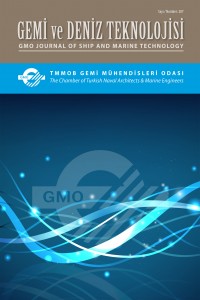Öz
The aim of the
present study is to develop a computer code for determining complete cycle, performance
parameters and exhaust emissions of diesel engines. For this purpose, a
computer program has been used and improved with new assumptions. To compute
diesel engine cycle, zero-dimensional intake and exhaust model given by Durgun,
zero-dimensional compression, combustion and expansion model given by Ferguson
have been used and improved with new assumptions. Using the developed computer
program, complete engine cycle, performance parameters and exhaust emissions can
be determined easily. The values of the cylinder
pressure and engine performance parameters predicted by the presented model
matched closely with the other theoretical models and experimental data. Also,
this program can be adapted and used practically for various parametric, alternative
fuel and water addition studies in diesel engines.
Anahtar Kelimeler
Diesel engine cycle Engine performance characteristics Simulation Models Computer Code
Kaynakça
- Bedford, F., Rutland, C., Dittrich P., Raab A., Wirbelit F. (2000). Effects of Direct Water Injection on DI Diesel Engine Combustion, SAE J. Automot. Eng., 01-2938.
- Durgun, O. (1991). A Practical Method for Calculation Engine Cycles, Union of Chambers of Turkish Eng. And Arc., Chamber of Mech. Eng., 383,18-29.
- Durgun, O., Sahin, Z. (2009). Theoretical Investigation of Heat Balance in Direct Injection (DI) Diesel Engines for Neat Diesel Fuel and Gasoline Fumigation, Energy Conversion and Management, 50, 43-51.
- Ferguson, R. (1986). Internal Combustion Engines-Applied Thermody, John Wiley & Sons, New York.
- Hardenberg, H.O., Hase, F.W. (1979). An Empirical Formula for Computing the Pressure Rise Delay of a Fuel from its Cetane Number and from the Relevant Parameters of Direct Injection Diesel Engines, SAE Paper 790493.
- Heywood, J.B. (1989). Internal Combustion Engines Fundamentals, McGraw Hill Book Company, New York.
- Kızıltan, E. (1988). Effect of Alcohol Addition to Motor Fuels on Engine Performance, Master Thesis, KTU Graduate School of Natural and Applied Sciences, Trabzon, [in Turkish].
- Kökkülünk, G., Gonca, G., Ayhan, V., Cesur, I., Parlak, A. (2013). Theoretical and Experimental Investigation of Diesel Engine with Steam Injection System on Performance and Emission Parameters, Applied Thermal Eng., 54, 161-170.
- Ottikkutti, P., Gerpen, JV., Cui, KR. (1991). Multi-zone Modeling of a Fumigated Diesel Engine, SAE, 910076:1–21.
- Pasternak, M., Mauss, F. (2009). Diesel Engine Cycle Simulation with a Reduced Set of Modeling Parameters Based on Detailed Kinetics, SAE, 01-0676.
- Qi, K., Feng, L., Leng, X., Du, B., Long, W. (2011). Simulation of quasi-dimensional combustion model for predicting diesel engine perf., Appl. Math. Model., 35, 930-40.
- Sahin, Z., Aksu, O. (2015). Experimental investigation of the effects of using low ratio n-butanol/diesel fuel blends on engine performance and exhaust emissions in a turbocharged DI diesel engine, Renewable Energy, 77, (279-290).
- Sahin, Z., Durgun, O. (2007a). High speed direct injection (DI) light-fuel (gasoline) fumigated vehicle diesel engine, Fuel, 86:388–99. 597.
- Sahin, Z., Durgun, O. (2007b). Theoretical investigation of effects of light fuel fumigation on Diesel engine performance and emissions, Energy Conversion & Management, 48, 1952–64.
- Sahin, Z., Durgun, O. (2008). Multi-zone Combustion Modeling for the Prediction of Diesel Engine Cycles and Engine Perf. Par., Appl. Therm. Eng., 28, 2245-2256.
- Sahin, Z., Tuti, M., Durgun, O. (2014). Experimental Investigation of the Effects of Water Adding to the Intake Air on the Engine Performance and Exhaust Emissions in a DI Automotive Diesel Engine, Fuel, 115:884-895.
- Savioli, T. (2015). CFD Analysis of 2-Stroke Engines, Energy Procedia, 81, 723-31.
- Shrivastava, R., Hessel, R., Reitz, R.D. (2002). CFD Optimization of DI Diesel Engine Performance and Emissions Using Variable Intake Valve Actuation with Boost Pressure, EGR and Multiple Injections, SAE, 2002-01-0959.
- Sindhu, R., Amba Prasad Rao, G., Madhu Murthy, K. (2014). Thermodynamic Modelling of Diesel Engine Processes for Predicting Engine Performance, International Journal of Applied Engineering and Technology, Vol. 4 (2).
- Tutak, W., Jamrozik, A. (2016). Validation and optimization of the thermal cycle for a diesel engine by computational fluid dynamics modeling, Appl. Math. Model., 40, 6293–6309.
- Tuti, M. (2012). Experimental Investigation of the Effects of Water Adding to the Intake Air on Engine Performance and Exhaust Emissions in Diesel Engines, Master Thesis, KTU Institute of Science, Trabzon, Turkey [in Turkish].
Ayrıntılar
| Bölüm | Makaleler |
|---|---|
| Yazarlar | |
| Yayımlanma Tarihi | 3 Nisan 2017 |
| Yayımlandığı Sayı | Yıl 2017 Sayı: 207 |


